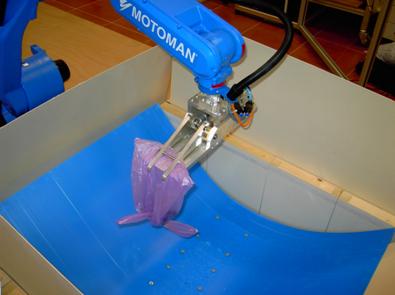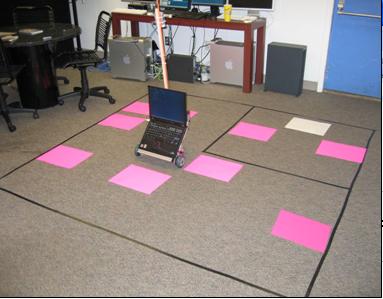Uri Carton, a student currently completing his third degree in the Department of Industrial Engineering and Management at Ben-Gurion University develops artificial intelligence algorithms that are applied to robots

Figure 1. A robotic arm learning how to empty a bag containing non-conventional explosives (under laboratory conditions)
In the Department of Industrial Engineering and Management at the Ben-Gurion University of the Negev, under the guidance of Prof. Helman Stern and Prof. Yael Iden, Uri Karton, a student who is currently completing his third degree, is developing artificial intelligence algorithms applied to robots. Uri Karton's main research deals with the improvement of algorithms from the Reinforcement Learning (RL) group, a subfield of artificial intelligence. In RL an agent (for example, a mobile robot) functions in the world or in a certain environment. While performing actions in the environment, the agent receives reinforcements (Reinforcements) or punishments (Punishments), indicators indicating how satisfactory his conduct is. According to these indicators, the agent learns how to conduct himself in the environment, which situations it is better to avoid and which actions he prefers to perform.
Uri Carton developed an algorithm called 
The strategy offered by the person is taken into account by the learning functions of the robot and the more the number of times the person intervenes, the higher the learning level of the robot improves and its dependence on the person decreases. At a certain point, the robotic system's dependence on humans decreases to such an extent that it actually turns from a semi-autonomous system to a system with full autonomy, that is, the degree of human intervention provides a measure to judge the system's level of autonomy - the less intervention there is, the greater its level of autonomy and it becomes more independent and has More efficient intelligence.
The research carried out in the Department of Industry and Management can be applied to applications developed by NASA, for example, an attempt to disconnect and shake solar panels on the space station in December 2006. If a robotic arm could be taught to shake a solar panel on the ground of the Earth while dealing with different situations (such as: changing angles, different materials, different lighting conditions, etc.) while mixing the person in situations where the robotic arm would have encountered difficulties, the same knowledge that I had gained by the computer systems of the robotic arm while performing experiments on the ground, could be applied in space whether sharing The operation with the robotic arm would be carried out by an astronaut operator or whether the operator was on Earth.
Another example of the integration of this research into NASA systems is a system that deals with the execution of a navigation task by a mobile robot. the algorithm

Figure 2. A mobile robot learning to perform a navigation task (under laboratory conditions)

3 תגובות
In relation to Machine Learning algorithms applied to robotics:
Stoccato has developed a classification technology capable of classifying signals (or data series) regardless of their type, their quantity, and their length. The technology is able to overcome the shortcomings of existing Machine Learning methods, such as the limitation in the number of features.
Based on the technology Stoccato has developed several search engines - for example, a financial search engine, in which all that is required of the user is to specify the name of an American security (ETF, or mutual fund). The results obtained are other securities that behaved in a similar way to the specified security, while stating the advantage of each result (for example, lower management fees, higher yield, lower risk, etc.). In this way, the user immediately receives an indication as to whether to invest in a security other than what he specified (thus avoiding, for example, unnecessary management fees).
Another search engine is designed to look for financial tools that behaved in the opposite way (Inverse).
Stoccato's vision is to include all existing financial tools in its search engines.
http://www.stockato.com
Great article, I invite you to browse my website for more information on the subject
To Avi Blizovsky, the astronauts went on a fourth spacewalk, according to the update